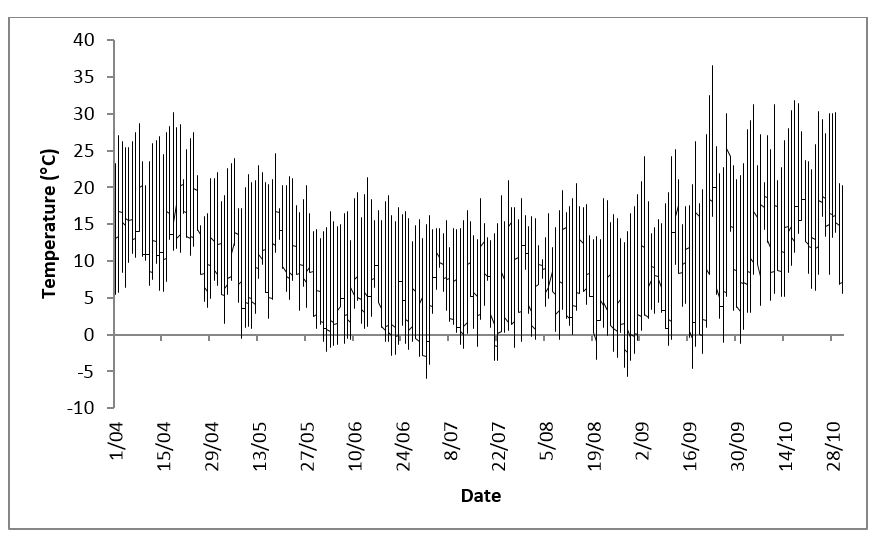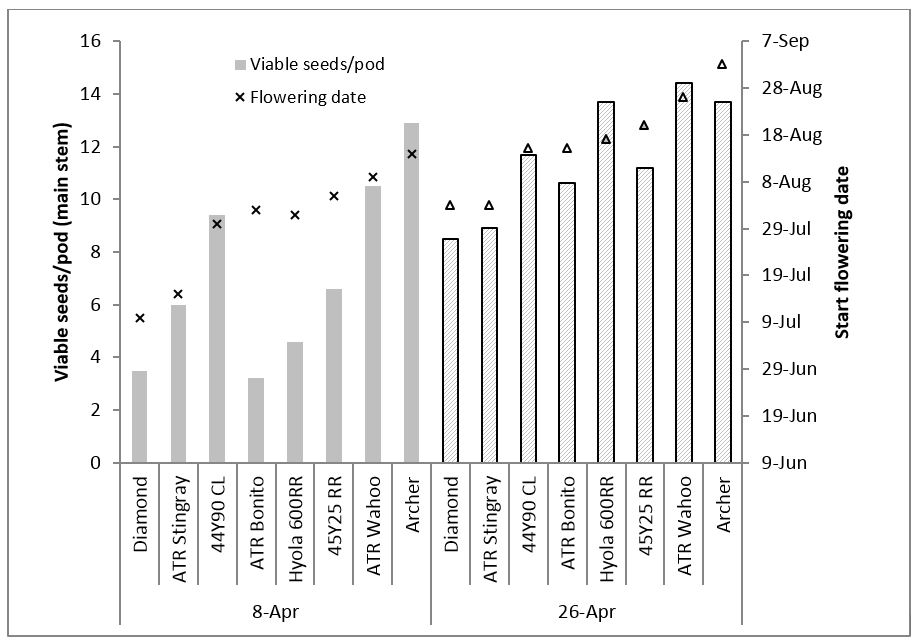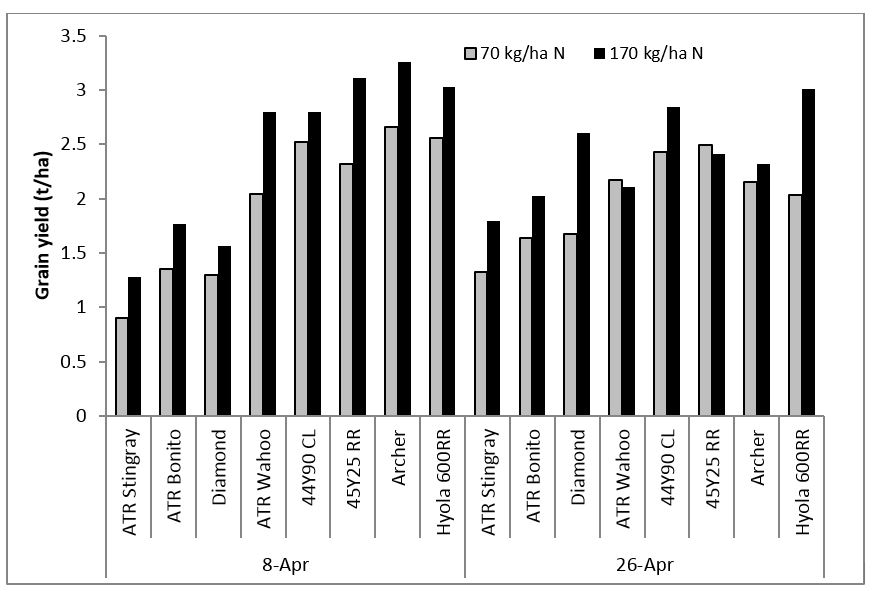Getting the best out of canola with in-crop agronomy
Getting the best out of canola with in-crop agronomy
Author: Rohan Brill (NSW DPI) Cameron Taylor (Birchip cropping Group) Ian Ludwig (SARDI) Danielle Malcolm (NSW DPI) Andrew Ware (SARDI) | Date: 27 Feb 2018
Take home messages
- Match canola varietal phenology with sowing date so that flowering starts at the optimum time for your environment.
- Hybrid canola varieties respond better than open-pollinated triazine tolerant (OP TT) varieties to high rates (above 100kg/ha) of nitrogen (N) provided flowering date is close to the optimum start of flowering (OSF) date.
- Moderate rates of N fertiliser (70kg/ha) can generate good returns even in relatively ‘risky’ environments (Mallee region).
- Canola can recover well from major frost damage especially where frost occurs in the early stages of reproductive development and where there is enough water available for the crop to set new pods.
Introduction
Canola performed well in most regions of Victoria (VIC) in 2017, especially where pre-crop agronomy (rotation, weed control, stubble management) was followed up with prudent in-crop agronomy (sowing date, variety choice, N management) that maximised the amount of N and water available to the crop and ensured that flowering occurred at the optimum time to limit exposure to stresses and to maximise growth. This paper will refer to optimum start of flowering dates (OSF) dates in the context of results from 2017.
What is the optimum start of flowering (OSF) date?
Collaborators (NSW DPI, CSIRO, SARDI and GRDC) in the Optimised Canola Profitability (OCP) project have recently released an eBook with OSF dates for most major canola growing locations from South Australia (SA) to Queensland (QLD). OSF dates are hen flowering should be targeted to start (defined as when 50% of plants have one open flower). For canola (like most crops), OSF dates are a balance between minimising the stresses of heat, frost, drought and disease, while maximising the crop’s ability to grow a high grain yield potential. Growers can target their OSF (Table 1) by selecting slow or mid-slow varieties (e.g. Archer, ATR Wahoo, Pioneer® 45Y91 (Clearfield® (CL)) from early sowing (before mid-April) or fast varieties (e.g. ATR Stingray, Nuseed Diamond, Hyola® 350TT, Pioneer® 43Y92 (CL)) from traditional (around 25 April) sowing dates.
Table 1. Optimum start of flowering dates (OSF) for key VIC locations plus Lameroo from SA and Wagga Wagga from New South Wales (NSW) (both with relevance for this paper).
| Location | OSF |
|---|---|
| Birchip | 13-July |
| Mildura | 14-July |
| Ouyen | 15-July |
| Lameroo¹ | 17-July |
| Wagga Wagga² | 5-August |
| Bendigo | 7-August |
| Horsham | 7-August |
| Shepparton | 7-August |
| Inverleigh | 9-August |
| Rutherglen | 14-August |
| Hamilton | 14-August |
¹ Lameroo is in the Mallee region of SA
² Wagga Wagga is in the eastern Riverina region of NSW
2017 research
This paper reports on results from three experimental sites in 2017 (Table 1). While two of the sites (Ganmain, NSW and Lameroo, SA) are not in VIC, their findings are directly relevant for nearby regions.
Table 2. Location, fallow rainfall (1 November to 31 March), in-crop rainfall (1 April to 31 October) and soil N at sowing at three canola experimental sites in 2017.
| Location | Region | Nov 16-Mar 17 Rainfall | Apr 17-Oct 17 Rainfall | Available N (sowing) |
|---|---|---|---|---|
| Longerenong | Wimmera, VIC | 130mm | 303mm | 77kg/ha |
| Ganmain | Riverina, NSW | 180mm | 190mm | 123kg/ha |
| Lameroo | Mallee, SA | 132mm | 258mm | 160kg/ha |
Each experiment was essentially the same, with the exclusion of Roundup Ready® varieties at Lameroo. Eight varieties (six at Lameroo) were sown at two sowing dates (early and traditional) with two rates of applied N. The actual N rates were different at each site, targeting a decile five and a decile nine yield level. Nitrogen to support decile five yield was applied to all treatments at sowing with the decile nine N treatment applied as topdressed urea in-crop (amount applied equalled the difference between the decile nine and decile five rates).
Table 3. Location, variety, N rate and sowing date for three experimental sites in 2017.
| Location | Varieties# | N Rate (D5 and D9) | Sowing date |
|---|---|---|---|
| Longerenong |
| 20 and 180kg/ha | 8 April and 28 April |
| Ganmain | 70 and 170kg/ha | 8 April and 26 April | |
| Lameroo | 20 and 70kg/ha | 21 April and 8 May |
*Hyola® 600RR and 45Y25 (RR) were not sown at Lameroo.
#ATR Stingray, ATR Bonito and ATR Wahoo are OP TT varieties. Nuseed Diamond is a hybrid conventional herbicide variety, Pioneer® 44Y90 (CL) and Archer are hybrid Clearfield® varieties and Hyola® 600RR and Pioneer® 45Y25 (RR) are hybrid Roundup Ready® varieties.
Longerenong
There was no effect of sowing date (or interactions with sowing date) on grain yields in 2017 as there was a much wider OSF window due to lower disease pressure, little frost (at this site) and likely a clearer winter with higher levels of incoming solar radiation (energy for the crop). There was, however, an interaction between variety and N rate (Table 4). For the five hybrid varieties, Nuseed Diamond, Pioneer® 44Y90 (CL), Pioneer® 45Y25 (RR), Hyola® 600RR and Archer, there was an average grain yield increase of 0.7t/ha from increasing the N rate from 20kg to 180 kg/ha, however the yield increase for the OP TT varieties, ATR Stingray, ATR Bonito and ATR Wahoo, was only (on average) 0.2t/ha.
Table 4. Grain yield of eight canola varieties with two rates of N applied at Longerenong, 2017.
| Variety | 20kg/ha | 180kg/ha |
|---|---|---|
| Diamond | 3.8 | 4.4 |
| ATR Stingray | 3.4 | 3.7 |
| 44Y90 (CL) | 3.7 | 4.4 |
| ATR Bonito | 3.4 | 3.6 |
| 45Y25 (RR) | 3.8 | 4.4 |
| Hyola® 600RR | 3.5 | 4.4 |
| ATR Wahoo | 3.5 | 3.8 |
| Archer | 3.6 | 4.0 |
| l.s.d. (var. * N) P=0.05 | 0.27t/ha | |
The high rate of N reduced oil concentration from 45.1% to 42.8% (averaged across all varieties). With only a modest grain yield increase from higher N for the OP TT varieties, there would have been an economic loss (assuming N cost of $1/kg) from increasing N rate from 20kg to 180 kg/ha (gross benefit of $42/ha), however the total gross income benefit for the hybrids was $291/ha (Table 5) which would have made the high N rate profitable. Hybrid seed is more expensive than OP TT but this cost would already have been repaid by higher yields at the low N rate.
Table 5. Grain yield (t/ha), oil concentration (%) and gross income ($/ha, assuming canola price of $500/tonne) of hybrid (all non-TT) and OP TT at two N rates.
| Grain yield (t/ha) | Oil (%) | Gross income ($/ha) | |
|---|---|---|---|
| 20kg/ha N | |||
| Hybrid | 3.7 | 45.2 | 1939 |
| OP TT | 3.4 | 45 | 1777 |
| 180kg/ha N | |||
| Hybrid | 4.4 | 42.9 | 2230 |
| OP TT | 3.6 | 42.7 | 1819 |
Ganmain
There were many severe frost events at Ganmain in 2017 (Figure 1) including 1 July (-5.5°C), 2 July (-4.1°C), 22 July (-3.5°C), 20 August (-3.4°C), 26 August (-3.1°C), 28 August (-4.4°C), 29 August (-5.7°C), 30 August (-3.5°C) and 17 September (-4.6°C). Rainfall was also well below average (long term average growing season rainfall = 275mm) and there was a heat event of 36.3°C on 23 September (giving a temperature range of 40.9°C in less than one week). Despite the extreme climatic conditions in 2017, average grain yield of the experiment (2.1t/ha) was still close to average for the region (1.8t to 2t/ha) due to deep stored water from spring rainfall in 2016.
Figure 1. Temperature (°C) from 1 April to 31 October at the Ganmain experimental site.
A frost scoring system was developed for Ganmain where the number of viable seeds was counted in 20 pods on the main stem in each plot. There was a strong relationship between flowering date and the number of viable seeds per pod (Figure 2). Early sown Nuseed Diamond and ATR Stingray flowered in early July and both averaged less than six seeds per pod. From the same sowing date, Archer and ATR Wahoo delayed flowering until early to mid August and both had more than ten viable seeds per pod. This scoring gave an insight into the level of frost damage in each variety, but did not completely relate to grain yield as there were differences in the ability to compensate (with new pods) following frost damage.
Figure 2. Viable seeds per pod (columns) and flowering date (× and Δ) of eight canola varieties sown at two sowing dates (averaged across N rates) at Ganmain, 2017 (viable seeds/pod l.s.d. P<0.05 = 2.1)
In this experiment (Figure 3), increased yield came from sowing varieties in their optimum window to achieve the OSF date (early to mid August) and where they were well fertilised with N. The fast varieties (Nuseed Diamond and ATR Stingray) were heavily penalised by frost where they were sown early and flowered early (see flowering dates in Figure 2) and the slower varieties (e.g. Archer and ATR Wahoo) had reduced yields from later sowing as flowering occurred later (late August) than optimal and pod development was limited by rising spring temperatures. Importantly, the N response increased for varieties sown in their correct window. For example, there was a strong response to N with Archer, Pioneer® 45Y25 RR and ATR Wahoo sown early (flowering in early August), but minimal response when sown later (flowering in later August). Conversely, there was a strong response to N for Nuseed Diamond when sown later (flowering in early August), but not where it was sown early (flowering in early July). Both Pioneer® 44Y90 CL and Hyola® 600RR responded well to N at both sowing dates (Figure 3).
There was an overall benefit of planting hybrid varieties, however varietal choice was less important than ensuring sowing date, phenology and N management were optimised. For example, the OP TT variety ATR Wahoo (2.8t/ha) sown early with a high rate of N yielded 0.7t/ha above the trial mean yield of 2.1t/ha, whereas there were several treatments where hybrids with inappropriate management yielded less than the trial mean.
Figure 3. Grain yield of eight canola varieties sown at two sowing dates and fertilised at two N rates at Ganmain, 2017 (l.s.d. P<0.05 = 0.38t/ha).
Lameroo
Lameroo is considered a relatively ‘risky’ environment for growing canola, however in 2017, there was a grain yield increase from planting hybrid varieties (compared with planting OP TT varieties) and applying a robust rate of N (70kg/ha) for the region (Table 6). Hybrid varieties yielded (on average) 0.2t/ha more than OP TT varieties and the 70kg/ha N rate yielded (on average) 0.4t/ha more than the 20kg/ha N rate. As the cost of hybrid seed was approximately the same as the cost of increasing N rate from 20kg/ha to 70kg/ha in 2017 (approximately $50/ha to $60/ha), the return on investment was greater for increasing N rate. Similar to Longerenong, there was no effect of sowing date on grain yield in 2017.
Table 6. Effect of N rate (two) and variety (six) on grain yield (averaged across two sowing dates) at Lameroo, 2017.
| Variety | 20kg/ha | 70kg/ha |
|---|---|---|
| Diamond | 1.6 | 2.0 |
| ATR Stingray | 1.4 | 1.9 |
| 44Y90 (CL) | 1.7 | 2.1 |
| ATR Bonito | 1.3 | 1.8 |
| ATR Wahoo | 1.4 | 1.8 |
| Archer | 1.3 | 1.7 |
| l.s.d. P=0.05 (N) | 0.13t/ha | |
| l.s.d. P=0.05 (variety) | 0.22t/ha | |
Conclusion
To get the best out of canola, ‘in-crop’ agronomy should focus on ensuring canola flowers close to the OSF date and the crop has access to enough N for its grain yield potential (aim for 80kg/ha available N per tonne of grain yield targeted). In medium to high yield potential situations, canola hybrids can increase profitability further, however the extra yield from hybrids (compared with OP TT) in lower yield potential sites may not be enough to warrant the extra cost.
In seasons with a ‘kind’ winter and spring, it may only be necessary for two of three of these factors to be in place. Winter and early spring conditions in 2017 were relatively benign (low frost, heat, drought and disease risk combined with high levels of radiation) across VIC and SA, hence there was little relationship between flowering date of canola and grain yield. Grain yield was maximised in experiments at these locations by choosing hybrid varieties and applying enough N to match the grain yield potential.
The experiment at Ganmain in the Riverina region of NSW highlighted the importance of matching sowing date and phenology so that crops flower close to the OSF date. At Ganmain, there was increased yield from applying a high rate of N and selecting hybrid varieties, but this was only observed on treatments that flowered from early to mid-August, on target for the simulated OSF date of 5 August for nearby Wagga Wagga.
Acknowledgements
The projects supporting this research are co-investments from GRDC, NSW DPI, CSIRO and SARDI.
The research undertaken as part of this project is made possible by the significant contributions of growers through both trial cooperation and the support of the GRDC. The author would like to thank them for their continued support. Thanks to technical staff for assistance including Danielle Malcolm and Warren Bartlett (NSW DPI), Amanda Pearce and Carolyne Hilton (SARDI).
Further reading
Ten tips for early sown canola
Contact details
Rohan Brill
Wagga Wagga Agricultural Institute
02 6938 1989
rohan.brill@dpi.nsw.gov.au



